Multichannel Approach for Arrayed Waveguide Grating-Based FBG Interrogation Systems
Abstract
1. Introduction
2. Theoretical Model
2.1. Analytical Approach
2.2. Interrogation Function
3. Methods
3.1. Setup Description: Optical Section
3.2. Electrical Section
3.3. Algorithm Considerations
4. Results
- -
- In order to achieve equivalent static state experimental characterizations, temperature solicitation was sensed by using three FBG having three different FWHM values. The aim of this experimental analysis is to prove that the interrogation capability with the proposed system is not depending on the FBG bandwidth. This peculiarity represents an advantage since, in the most employed interrogation systems based on the reconstruction of the FBG spectrum (e.g., based on tunable laser), a high FBG bandwidth (more than 200 pm) may increase the uncertainty on the Bragg wavelength position. Furthermore, high-bandwidth FBG are less expensive and usually show a Gaussian trend of reflectance closer to the first order.
- -
- As dynamic experiments, the system was tested by using high-frequency strain stresses and an FBG glued on an aluminum plate in order to prove the feasibility. A first vibration test was sensed in the range of hundreds of hertz by beating with a hammer the plate, while, in a subsequent measurement, a pressure signal generated by a piezoelectric probe, in the order to test in MHz range, was sensed as well. The goal of these experiments was to prove that with the proposed optical section, in which passive devices are employed, the proposed concept is able to behave as the currently used interrogation system, also working in applications (as the high-frequency detection) in which the well assessed tunable filter-based interrogators are not suitable due to the limits on the read-out and numerical elaboration speed.
- A voltage offset given by the electrical circuitry was compensated.
- An additional compensation was done in order to avoid the crosstalk noise among the AWG channels.
- A slope correction was done minimizing the error given by the non-ideal Gaussian trend.
4.1. Temperature Measurements
4.1.1. Test by Using 200 pm FWHM FBG
4.1.2. Test by Using 315 pm FWHM FBG
4.1.3. Test by Using 500 pm FWHM FBG
4.2. Strain Dynamic Measurements
4.3. High-Speed Measurements
4.4. Relationship Curve between and Interrogation Function (F)
4.5. Memory Requirement Comparison between Proposed Detection Algorithm and LUT Approach
5. Conclusions
Author Contributions
Funding
Data Availability Statement
Conflicts of Interest
Appendix A
| Ports | Wavelength [nm] | Max IL [dB] | Ripple [dB] | FWHM [GHz] |
|---|---|---|---|---|
| 35 | 1549.315 | 3.78 | 0.14 | 79.22 |
| 34 | 1550.116 | 3.96 | 0.19 | 78.04 |
| 33 | 1550.918 | 3.94 | 0.14 | 78.96 |
| 32 | 1551.721 | 3.89 | 0.18 | 77.80 |
| 28 | 1554.960 | 3.74 | 0.16 | 77.54 |
| 27 | 1555.747 | 3.74 | 0.18 | 78.21 |
| 26 | 1556.555 | 3.80 | 0.17 | 77.45 |
References
- Rao, Y.-J. In-fibre Bragg grating sensors. Meas. Sci. Technol. 1997, 8, 355–375. [Google Scholar] [CrossRef]
- Kersey, A.D.; Davis, M.A.; Patrick, H.J.; Leblanc, M.; Koo, K.P.; Askins, C.G.; Putnam, M.A.; Friebele, E.J. Fiber grating sensors. J. Light. Technol. 1997, 15, 1442–1463. [Google Scholar] [CrossRef]
- Libish, T. Fiber Gratings: Basic Theory and Sensing Principle. Ph.D. Thesis, Cochin University of Science and Technology, Kerala, India, 2015; pp. 21–79. [Google Scholar]
- Loupos, K.; Amditis, A. Structural Health Monitoring Fiber Optic Sensors. Smart Sens. Meas. Instrum. 2017, 21, 185–206. [Google Scholar] [CrossRef]
- Bremer, K.; Wollweber, M.; Weigand, F.; Rahlves, M.; Kuhne, M.; Helbig, R.; Roth, B. Fibre Optic Sensors for the Structural Health Monitoring of Building Structures. Procedia Technol. 2016, 26, 524–529. [Google Scholar] [CrossRef]
- López-Higuera, J.M.; Quintela, A.; Madruga, F.J.; Conde, O.M.; Lomer, M.; Quintela, M.A.; Rodríguez, L.; Cobo, A.; Mirapeix, J. Fiber optics in structural health monitoring. In Proceedings of the 2010 Conference on Optical Fiber Communication (OFC/NFOEC), Collocated National Fiber Optic Engineers Conference, San Diego, CA, USA, 21–25 March 2010. [Google Scholar]
- Murayama, H.; Wada, D.; Igawa, H. Structural health monitoring by using fiber-optic distributed strain sensors with high spatial resolution. Photonic Sens. 2013, 3, 355–376. [Google Scholar] [CrossRef]
- Selvaggio, M.; Fontanelli, G.A.; Marrazzo, V.R.; Bracale, U.; Irace, A.; Breglio, G.; Villani, L.; Siciliano, B.; Ficuciello, F.; Bregio, G. The MUSHA underactuated hand for robot-aided minimally invasive surgery. Int. J. Med. Robot. Comput. Assist. Surg. 2019, 15, e1981. [Google Scholar] [CrossRef]
- Consales, M.; Buosciolo, A.; Cutolo, A.; Breglio, G.; Irace, A.; Buontempo, S.; Petagna, P.; Giordano, M.; Cusano, A. Fiber optic humidity sensors for high-energy physics applications at CERN. Sens. Actuators B Chem. 2011, 159, 66–74. [Google Scholar] [CrossRef]
- Makovec, A.; Berruti, G.; Consales, M.; Giordano, M.; Petagna, P.; Buontempo, S.; Breglio, G.; Szillasi, Z.; Beni, N.; Cusano, A. Radiation hard polyimide-coated FBG optical sensors for relative humidity monitoring in the CMS experiment at CERN. J. Instrum. 2014, 9, C03040. [Google Scholar] [CrossRef]
- Avino, S.; D’Avino, V.; Giorgini, A.; Pacelli, R.; Liuzzi, R.; Cella, L.; Gagliardi, G.; De Natale, P. Radiation dosimetry with fiber Bragg gratings. In Proceedings of the 23rd International Conference on Optical Fiber Sensors (OFS2014), Santander, Spain, 2–6 June 2014; Volume 9157, p. 91574. [Google Scholar] [CrossRef]
- Chiuchiolo, A.; Bajas, H.; Bajko, M.; Castaldo, B.; Consales, M.; Cusano, A.; Giordano, M.; Giloux, C.; Pérez, J.C.; Sansone, L.; et al. Cryogenic test facility instrumentation with fiber optic and fiber optic sensors for testing superconducting accelerator magnets. IOP Conf. Ser. Mater. Sci. Eng. 2017, 278, 012082. [Google Scholar] [CrossRef]
- Fienga, F.; Szillasi, Z.; Beni, N.; Irace, A.; Gaddi, A.; Zeuner, W.; Ball, A.; Buontempo, S.; Breglio, G. A fiber optic sensors monitoring system for the central beam pipe of the CMS experiment. Opt. Laser Technol. 2019, 120, 105650. [Google Scholar] [CrossRef]
- Fienga, F.; Beni, N.; Breglio, G.; Buontempo, S.; Consales, M.; Cusano, A.; Gaddi, A.; Irace, A.; Giordano, M.; Szillasi, Z. Fibre optic sensors structural health monitoring of the central beam pipe in the CMS experiment at the CERN laboratories. In Proceedings of the European Workshop on Structural Health Monitoring (EWSHM 2016), Bilbao, Spain, 5–8 July 2016; Volume 2, pp. 1018–1025. [Google Scholar]
- Fienga, F.; Buontempo, S.; Breglio, G.; Cusano, A.; Irace, A.; Beni, N.; Giordano, M.; Szillasi, Z.; Consales, M.; Gaddi, A.; et al. Fiber optic sensors structural monitoring of the beam pipe in the CMS experiment at the CERN. In Proceedings of the 2015 Fotonica AEIT Italian Conference on Photonics Technologies, Turin, Italy, 6–8 May 2015. [Google Scholar]
- Fienga, F.; Marrazzo, V.R.; Spedding, S.B.; Szillasi, Z.; Beni, N.; Irace, A.; Zeuner, W.; Ball, A.; Vaccaro, V.G.; Salvant, B.; et al. Fiber Bragg Grating Sensors as Innovative Monitoring Tool for Beam Induced RF Heating on LHC Beam Pipe. J. Light. Technol. 2021, 39, 4145–4150. [Google Scholar] [CrossRef]
- Chan, J.C.C. Interrogation of Fiber Bragg Grating Sensors with a Tunable Laser Source. Ph.D. Thesis, Hong Kong Polytechnic University, Hong Kong, China, 2000. [Google Scholar]
- Todd, M.D.; Johnson, G.A.; Althouse, B.L. A novel Bragg grating sensor interrogation system utilizing a scanning filter, a Mach-Zehnder interferometer and a 3×3 coupler. Meas. Sci. Technol. 2001, 12, 771–777. [Google Scholar] [CrossRef]
- Song, M.; Yin, S.; Ruffin, P.B. Fiber bragg grating strain sensor demodulation with quadrature sampling of a Mach-Zehnder interferometer. Appl. Opt. 2000, 39, 1106–1111. [Google Scholar] [CrossRef]
- Alves, J.; Santos, J.L.; De Carvalho, A.L.B.; Lage, A.P. Fiber Bragg sensor interrogation system based on a CCD spectrometer. Proc. IEEE Sens. 2004, 2, 909–913. [Google Scholar] [CrossRef]
- Tosi, D. Improved KLT Algorithm for High-Precision Wavelength Tracking of Optical Fiber Bragg Grating Sensors. J. Sens. 2017, 2017, 1–10. [Google Scholar] [CrossRef]
- Perry, M.; Orr, P.; Niewczas, P.; Johnston, M. High-Speed Interferometric FBG Interrogator Measurement Capability. J. Light. Technol. 2013, 31, 2897–2903. [Google Scholar] [CrossRef]
- Tsai, P.; Sun, F.; Xiao, G.; Zhang, Z.; Rahimi, S.; Ban, D. A New Fiber-Bragg-Grating Sensor Interrogation System Deploying Free-Spectral-Range-Matching Scheme with High Precision and Fast Detection Rate. IEEE Photonics Technol. Lett. 2008, 20, 300–302. [Google Scholar] [CrossRef]
- Saito, T.; Nara, K.; Nekado, Y.; Hasegawa, J.; Kashihara, K. 100 GHz-32 ch athermal AWG with extremely low temperature dependency of center wavelength. In Proceedings of the Optical Fiber Communication Conference, Atlanta, GA, USA, 23 March 2003; p. MF4. [Google Scholar]
- Marrazzo, V.R.; Riccio, M.; Maresca, L.; Irace, A.; Breglio, G. Wide range AWG-based fbg interrogation system with improved sensitivity. In Proceedings of the PRIME 2019—15th Conference on Ph.D. Research in Microelectronics and Electronics, Lausanne, Switzerland, 15–18 July 2019; pp. 149–152. [Google Scholar] [CrossRef]
- Marrazzo, V.R.; Fienga, F.; Riccio, M.; Maresca, L.; Irace, A.; Breglio, G. Simulation of an Optical-to-Digital Converter for High Frequency FBG Interrogator. Lect. Notes Electr. Eng. 2020, 627, 259–265. [Google Scholar] [CrossRef]
- Wu, W.; Liu, X. Fiber Bragg grating sensors interrogation system using arrayed waveguide gratings demultiplexer. In Proceedings of the Asia Communications and Photonics Conference and Exhibition, Shanghai, China, 2–6 November 2009; Volume 7630, pp. 1–6. [Google Scholar] [CrossRef]
- Niewczas, P.; Willshire, A.; Dziuda, L.; McDonald, J. Performance Analysis of the Fiber Bragg Grating Interrogation System Based on an Arrayed Waveguide Grating. IEEE Trans. Instrum. Meas. 2004, 53, 1192–1196. [Google Scholar] [CrossRef]
- Fusiek, G.; Niewczas, P.; Willshire, A.; McDonald, J. Nonlinearity Compensation of the Fiber Bragg Grating Interrogation System Based on an Arrayed Waveguide Grating. IEEE Trans. Instrum. Meas. 2008, 57, 2528–2531. [Google Scholar] [CrossRef][Green Version]
- Willshire, A.; Niewczas, P.; Dziuda, L.; Fusiek, G.; McDonald, J.R. Dynamic Strain Measurement Using an Extrinsic Fabry–Perot Interferometric Sensor and an Arrayed Waveguide Grating Device. IEEE Trans. Instrum. Meas. 2004, 53, 4–9. [Google Scholar] [CrossRef]
- Marrazzo, V.R.; Fienga, F.; Laezza, D.; Riccio, M.; Irace, A.; Buontempo, S.; Breglio, G. Full Analog Fiber Optic Monitoring System Based on Arrayed Waveguide Grating. J. Light. Technol. 2021, 39, 4990–4996. [Google Scholar] [CrossRef]
- Weng, S.; Yuan, P.; Zhuang, W.; Zhang, D.; Luo, F.; Zhu, L. SOI-Based Multi-Channel AWG with Fiber Bragg Grating Sensing Interrogation System. Photonics 2021, 8, 214. [Google Scholar] [CrossRef]
- Abdelsalam, A.M.; Langlois, J.M.P.; Cheriet, F. A configurable FPGA implementation of the Tanh function using DCT interpolation. In Proceedings of the 25th Annual International Symposium on Field-Programmable Custom Computing Machines (FCCM), Napa, CA, USA, 30 April–2 May 2017; pp. 168–171. [Google Scholar]
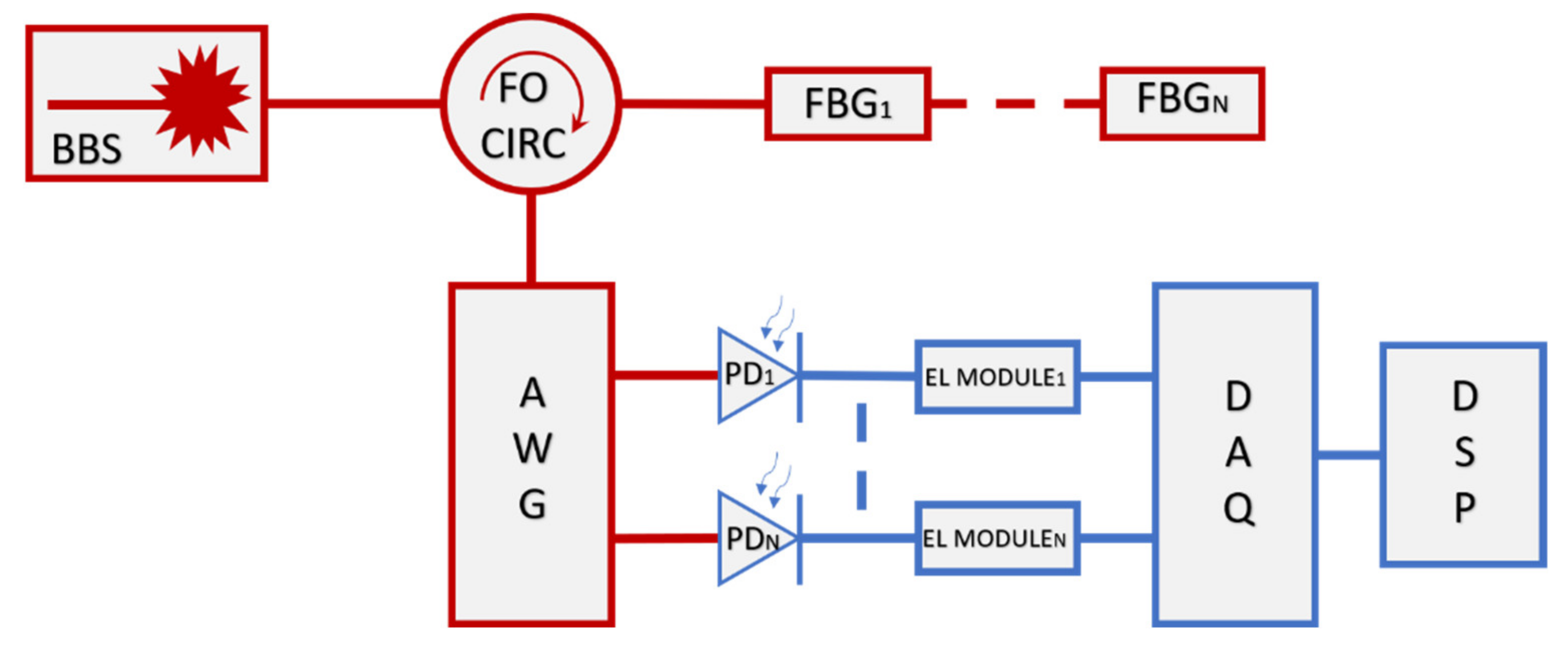
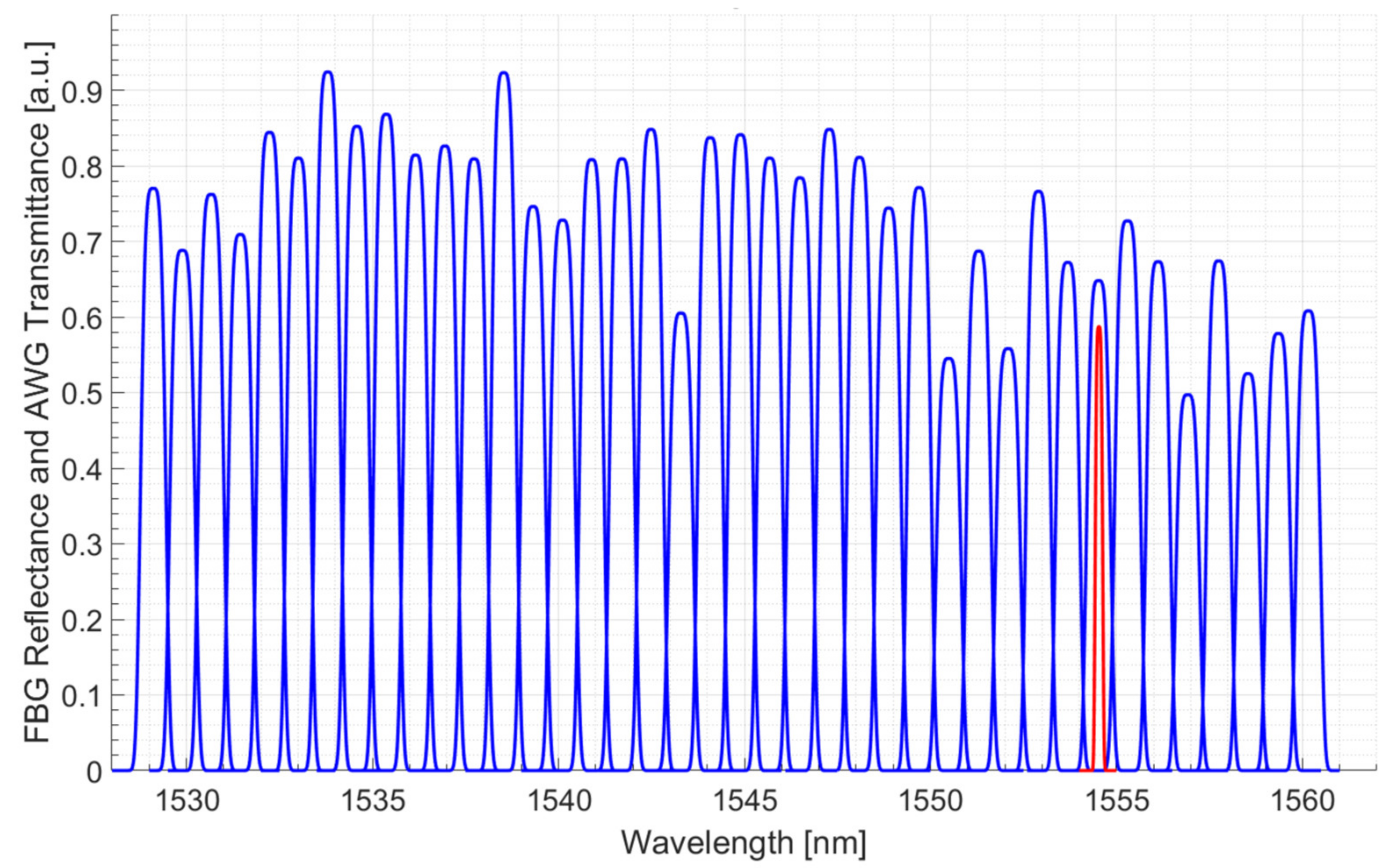
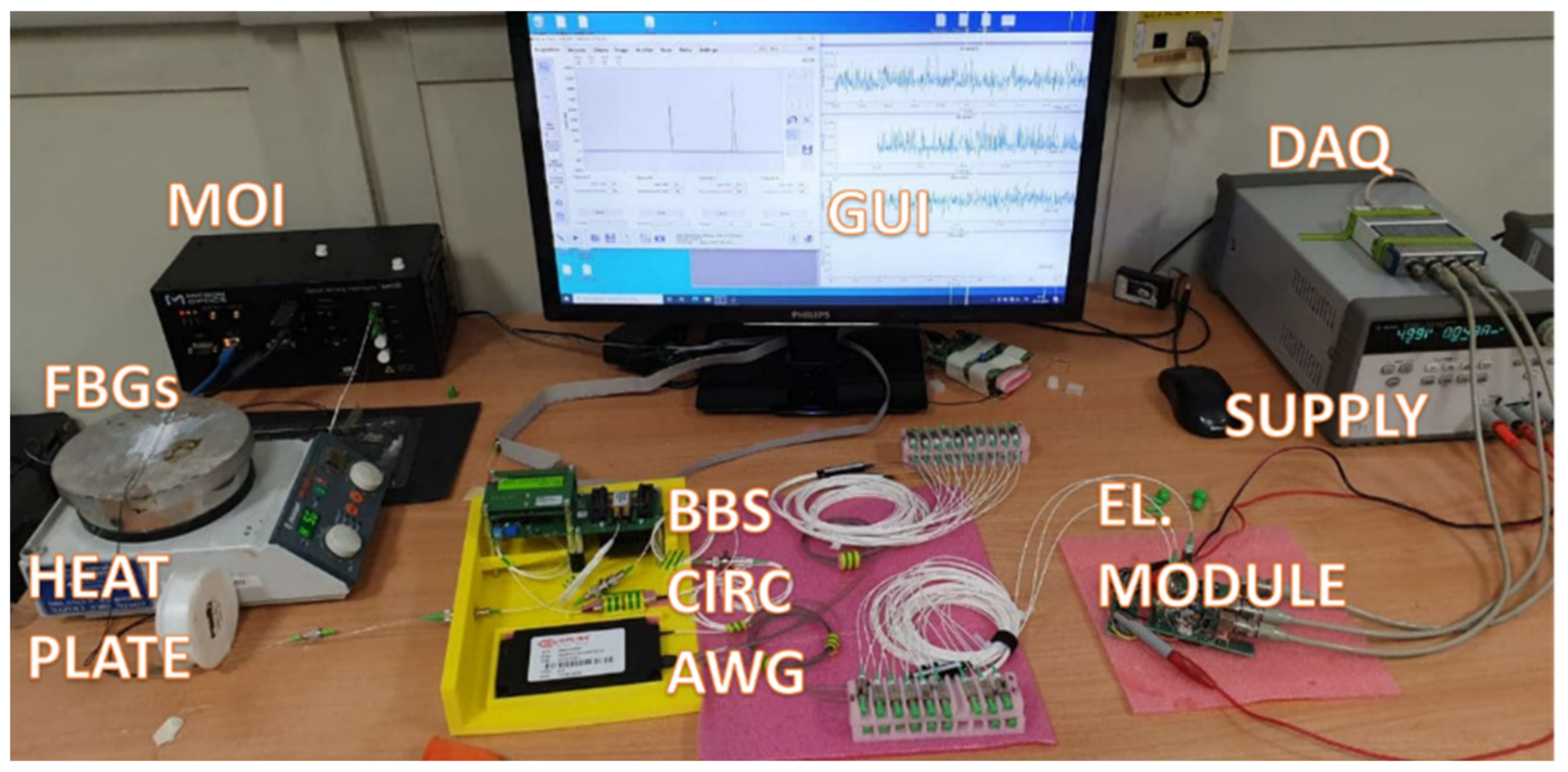
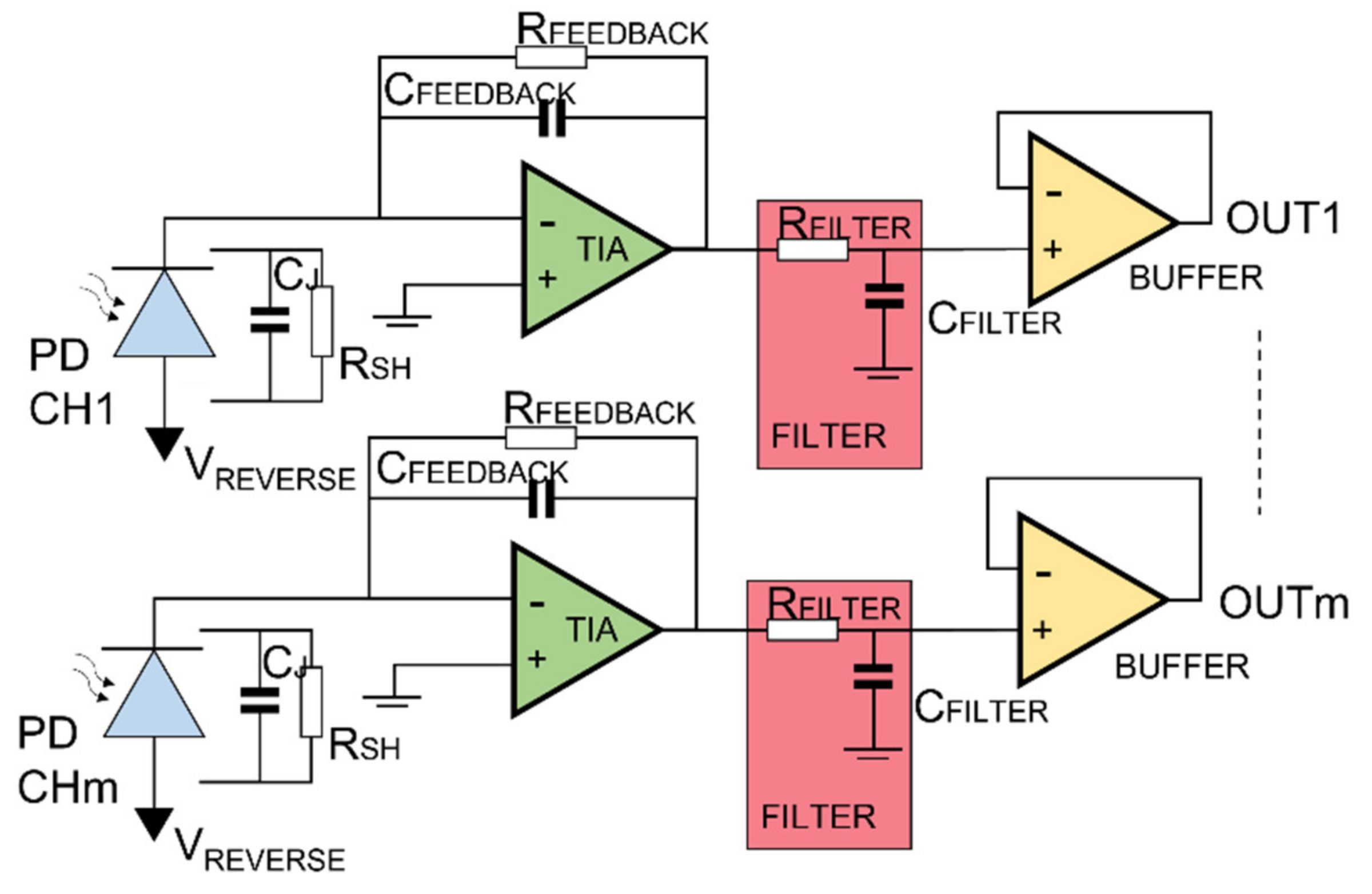
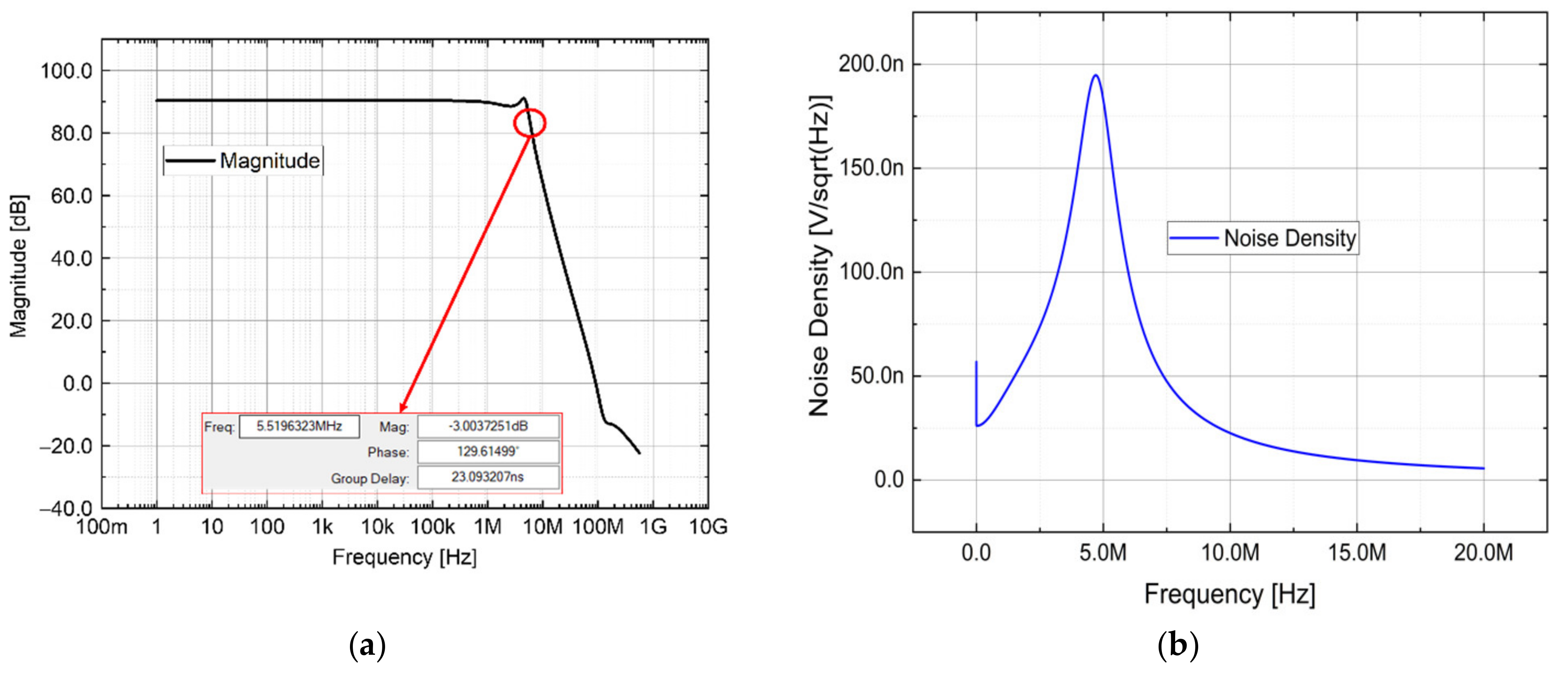

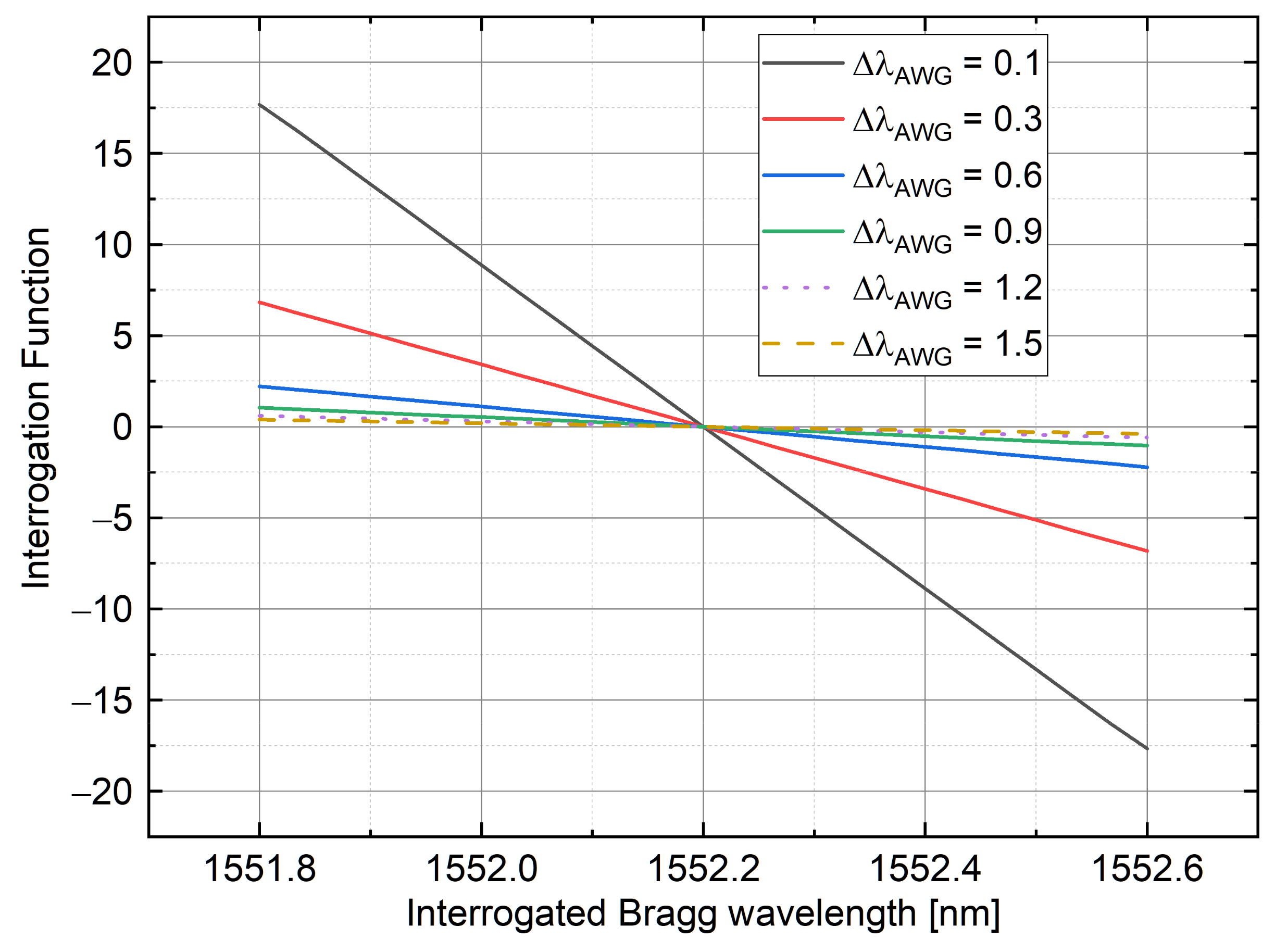
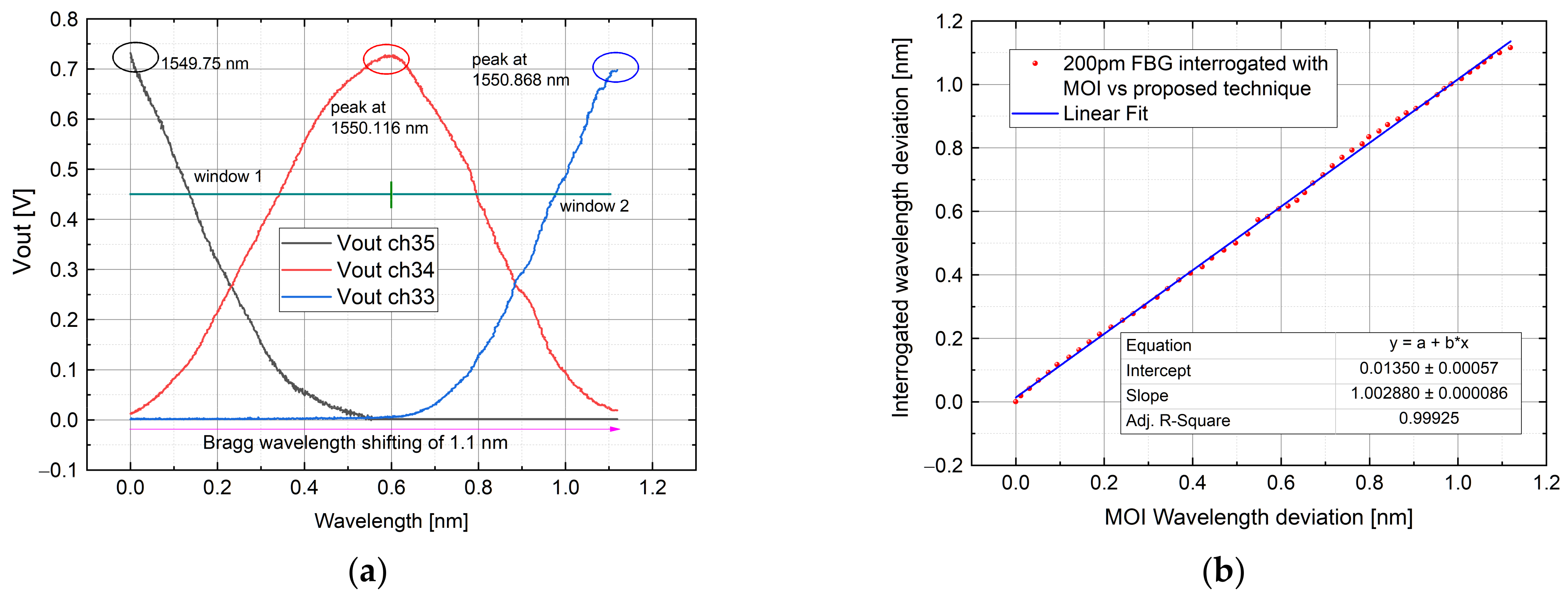

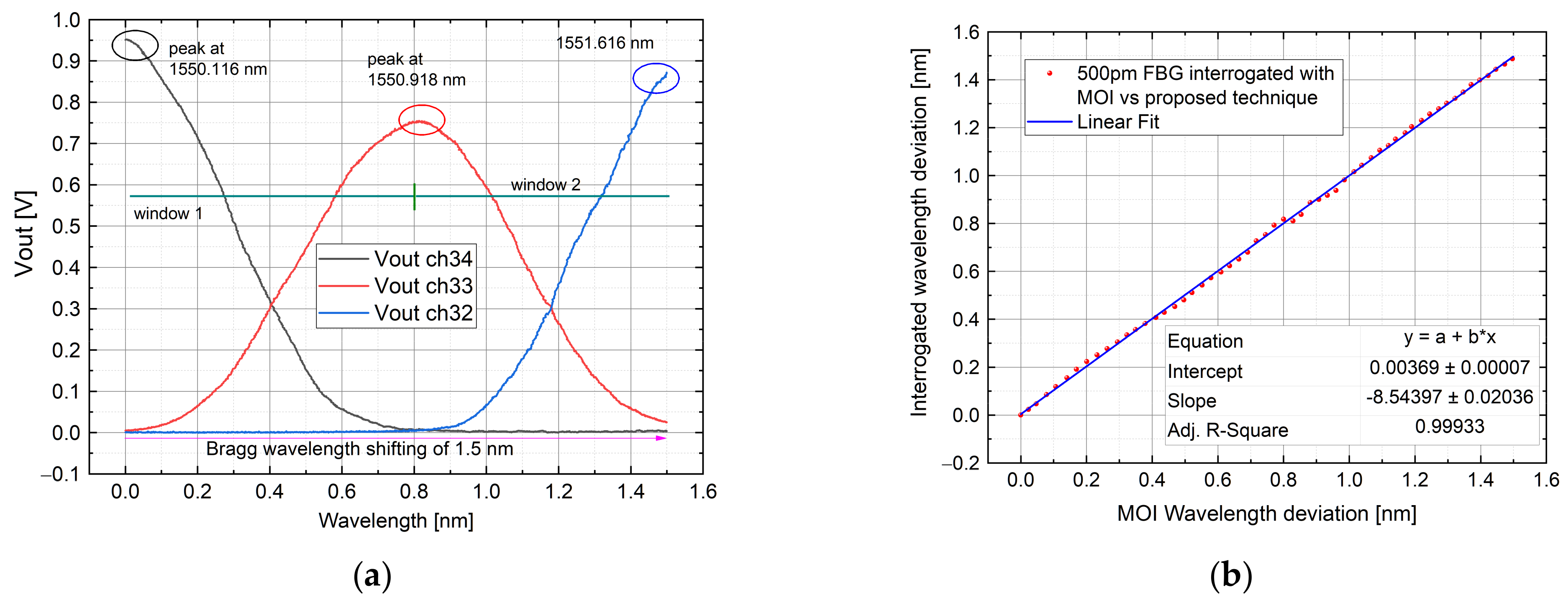
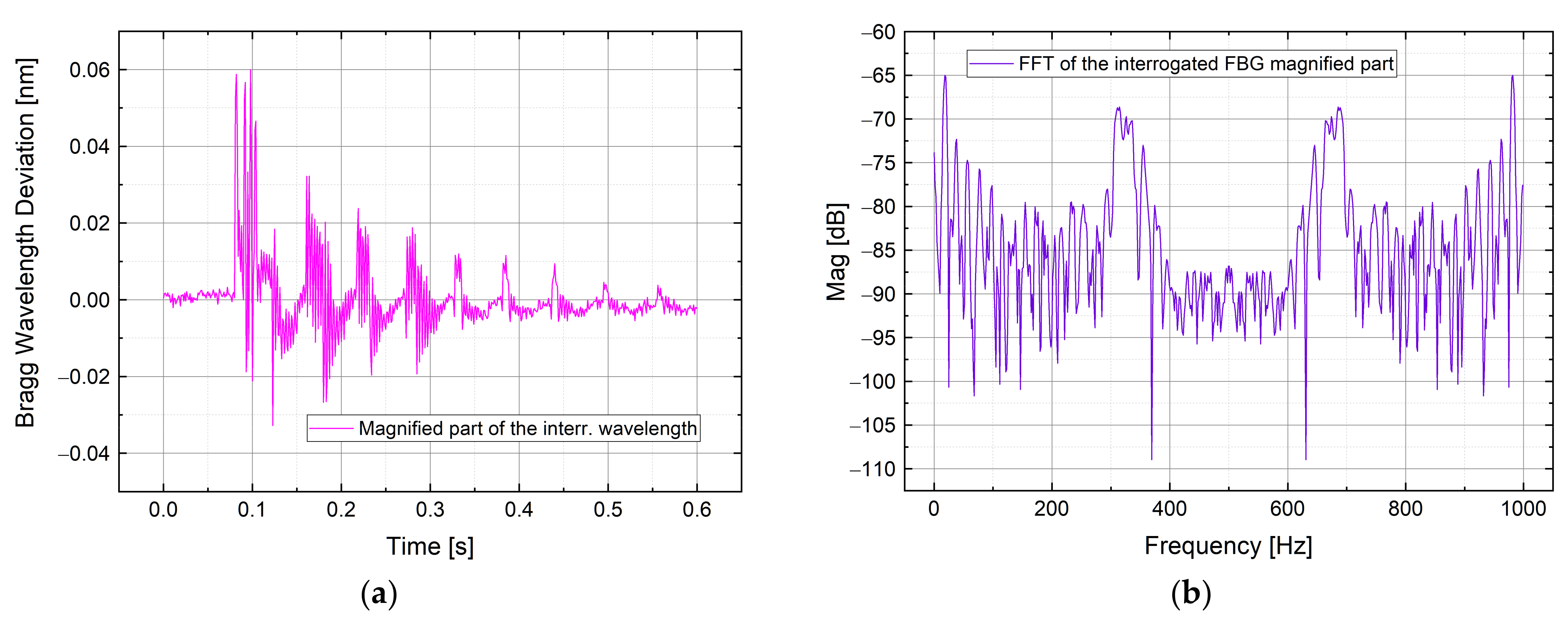

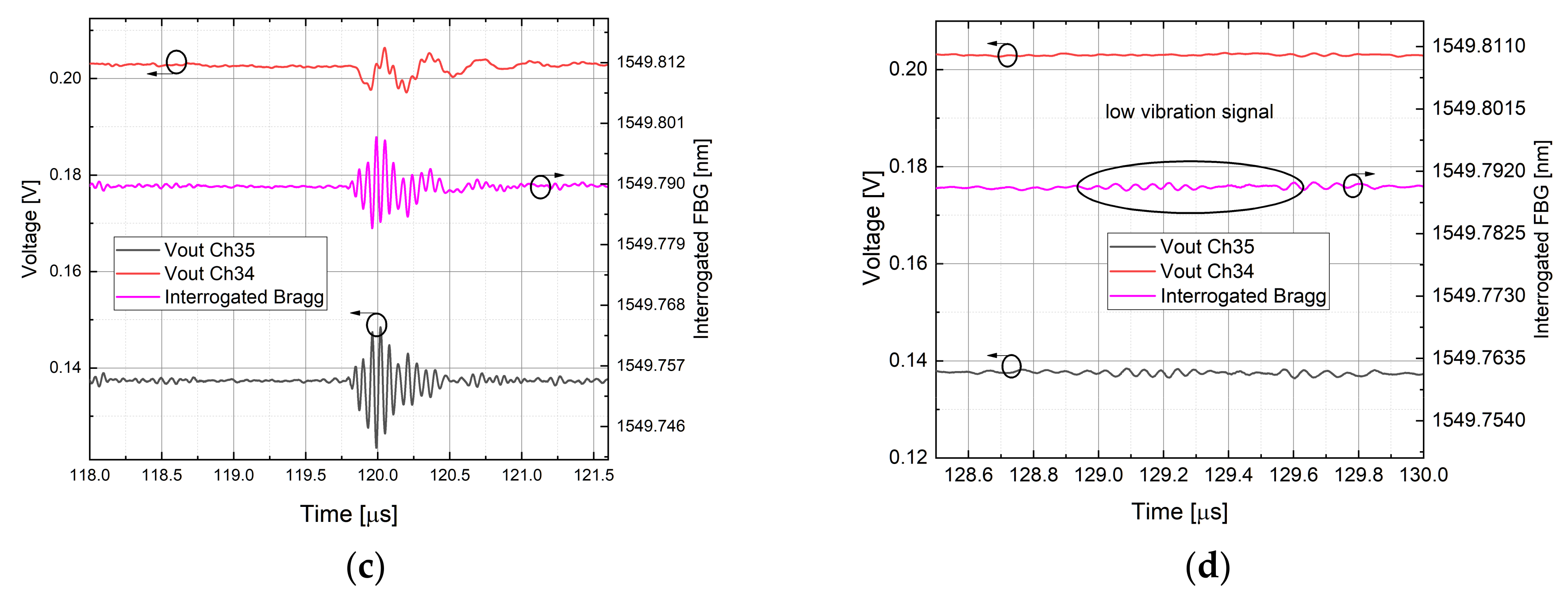
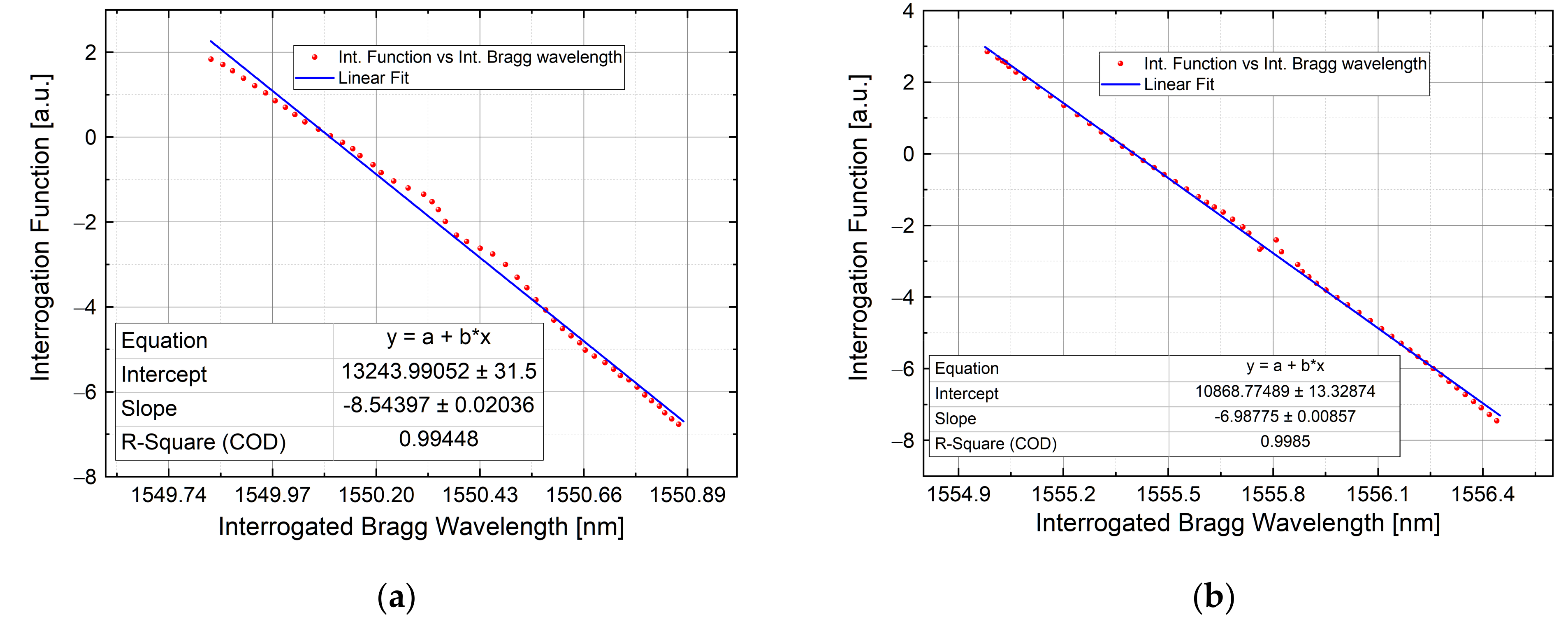

| Test | ||
|---|---|---|
| 200 pm static | −8.54 ± 0.02 | 13244 ± 31 |
| 315 pm static | −6.9877 ± 0.0086 | 10868.77 ± 13.33 |
| 500 pm static | −6.6299 ± 0.0073 | 10278.85 ± 11.36 |
| 200 pm high-speed | −5.75 ± 0.93 | 8909.56 ± 1.44 |
Publisher’s Note: MDPI stays neutral with regard to jurisdictional claims in published maps and institutional affiliations. |
© 2021 by the authors. Licensee MDPI, Basel, Switzerland. This article is an open access article distributed under the terms and conditions of the Creative Commons Attribution (CC BY) license (https://creativecommons.org/licenses/by/4.0/).
Share and Cite
Marrazzo, V.R.; Fienga, F.; Riccio, M.; Irace, A.; Breglio, G. Multichannel Approach for Arrayed Waveguide Grating-Based FBG Interrogation Systems. Sensors 2021, 21, 6214. https://doi.org/10.3390/s21186214
Marrazzo VR, Fienga F, Riccio M, Irace A, Breglio G. Multichannel Approach for Arrayed Waveguide Grating-Based FBG Interrogation Systems. Sensors. 2021; 21(18):6214. https://doi.org/10.3390/s21186214
Chicago/Turabian StyleMarrazzo, Vincenzo Romano, Francesco Fienga, Michele Riccio, Andrea Irace, and Giovanni Breglio. 2021. "Multichannel Approach for Arrayed Waveguide Grating-Based FBG Interrogation Systems" Sensors 21, no. 18: 6214. https://doi.org/10.3390/s21186214
APA StyleMarrazzo, V. R., Fienga, F., Riccio, M., Irace, A., & Breglio, G. (2021). Multichannel Approach for Arrayed Waveguide Grating-Based FBG Interrogation Systems. Sensors, 21(18), 6214. https://doi.org/10.3390/s21186214








